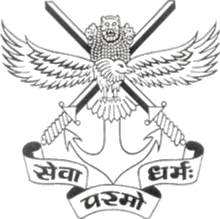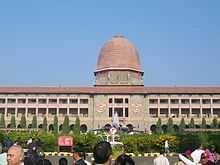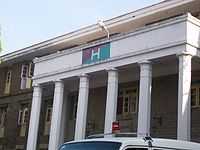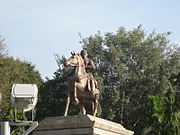National Defence Academy
| National Defence Academy | |
|---|---|
 | |
| Motto |
सेवा परमो धर्म: (sēvā paramō dharma) |
| Motto in English | Service Before Self |
| Established | 7 December 1954 |
| Type | Military Academy |
| Commandant | Air Marshal Kulwanth Singh Gill, AVSM, YSM, VM |
| Location | Khadakwasla, Maharashtra, India |
| Campus | 7,015 acres (28.39 km2) |
| Colors |
Maroon[1] |
| Affiliations | Jawaharlal Nehru University |
| Website | nda.nic.in |
The National Defence Academy (NDA) is the Joint Services academy of the Indian Armed Forces, where cadets of the three services, the Army, the Navy and the Air Force train together before they go on to pre-commissioning training in their respective service academies. The NDA is located in Khadakwasla near Pune, Maharashtra. It is the first tri-service academy in the world and is rated amongst the best in the world.
NDA alumni have led and fought in every major conflict in which the Indian Armed Forces has been called to action since the academy was established. The alumni include 3 Param Vir Chakra recipients and 9 Ashoka Chakra recipients.
History

In 1941, Lord Linlithgow, then Governor-General of India received a gift of £100,000 from a grateful Sudanese Government towards building a war memorial in recognition of the sacrifices of Indian troops in the liberation of Sudan in the East African Campaign during World War II. At the end of the war, Field Marshal Claude Auchinleck, then Commander-in-Chief of the Indian Army, drawing on experiences of the army during the war, led a committee to study various military academies around the world and submitted a report to the Government of India in Dec. 1946. The committee recommended the establishment of a Joint Services Military Academy, with training modelled on the United States Military Academy at West Point.[2]
After the independence of India in Aug. 1947, the Chiefs of Staff Committee immediately implemented the recommendations of the Auchinleck report. The committee initiated an action plan in late 1947 to commission a permanent defence academy and began the search for a suitable site. It also decided to set up an interim training academy, known as the Joint Services Wing (JSW), which was commissioned on 1 Jan. 1949 at the Armed Forces Academy (now known as the Indian Military Academy) in Dehradun. Initially, after two years of training at the JSW, Army cadets went on to the Military wing of the AFA for two years of further pre-commission training, while the Navy and Air Force cadets were sent to Dartmouth and Cranwell in the United Kingdom for further training.
Following partition, India's share of the monetary gift received from Sudan, amounted to £70,000 (the remaining £30,000 went to Pakistan). The Indian Army decided to use these funds to partly cover the cost of construction of the NDA. The foundation stone for the academy was laid by then Prime Minister of India, Jawaharlal Nehru on 6 Oct. 1949. The National Defence Academy was formally commissioned on 7 Dec. 1954, with an inauguration ceremony held on 16 Jan. 1955.[3] The JSW program was transferred from the AFA to the NDA.
Campus

The NDA campus is located about 17 km south-west of Pune city, north-west of Khadakwasla Lake. It spans 7,015 acres (28.39 km2) of the 8,022 acres (32.46 km2) donated by the Government of the former Bombay State. The site was chosen for being on a lake shore, the suitability of the neighboring hilly terrain, proximity to the Arabian Sea and other military establishments, an operational air base nearby at Lohegaon as well as the salubrious climate. The existence of an old combined-forces training centre and a disused mock landing ship, HMS Angostura, on the north bank of the Khadakwasla lake which had been used to train troops for amphibious landings, lent additional leverage for the selection of the site.[2] Aptly, NDA is also located in the hunting grounds of the legendary Shivaji, with the Sinhagad Fort as a panoramic backdrop.
The administrative headquarters of the NDA was named the Sudan Block, in honour of the sacrifices of Indian soldiers in the Sudan theatre during the East African Campaign. It was inaugurated by then Ambassador of Sudan to India, Rahmatullah Abdulla, on 30 May 1959. The building is a 3-storey basalt and granite structure constructed with Jodhpur red sandstone. Its architecture features an exterior design comprising a blend of arches, pillars and verandahs, topped by a dome. The foyer has white Italian marble flooring and panelling on the interior walls. On the walls of the foyer hang the portraits of NDA graduates who have been honored with the highest gallantry awards, the Param Vir Chakra or the Ashoka Chakra.
A number of war relics adorn the NDA campus, including legendary captured tanks and aircraft.[4] The Vyas Library offers an extensive collection of over 100,000 printed volumes, in addition to numerous electronic subscriptions and a number of periodicals and journals from around the world in at least 10 languages.
Admission

Applicants to the NDA are selected via a written exam conducted by the UPSC, followed by extensive interviews covering general aptitude, psychological testing, team skills as well as physical and social skills, along with medical tests. Incoming classes are accepted twice a year for semesters starting in July and January. About 320,000 applicants sit for each written exam. Typically, about 9,000 of these are invited to interview. Applicants to join the Air Force also go through a Pilot Aptitude Battery Test. About 300-350 cadets are accepted to the academy each semester. About 66 cadets are accepted for the Air Force, 39 for the Navy and 195 for the Army.
Cadets who are accepted and successfully complete the program are sent to their respective training academies for one year of training before granting of commission: army cadets go to IMA at Dehradun, Air Force cadets to AFA at Dundigal, Hyderabad, and naval cadets to INA, Ezhimala, Kerala. A cadet can only decline a commission in case of a serious permanent medical condition caused during the program.[5]
Curriculum
Academics
The NDA offers only a full-time, residential undergraduate program. Cadets are awarded a Baccalaureate degree (a Bachelor of Arts or a Bachelor of Science or a "Bachelor of Technology" ) after 3 years of study. Cadets have a choice of two streams of study. The Science stream offers studies in Physics, Chemistry, Mathematics and Computer Science. The Humanities (Liberal Arts) stream offers studies in History, Economics, Political Science, Geography and Languages.
In both streams, academic studies are split into three categories.
- In the Compulsory Course, cadets study English, Foreign Languages (Arabic, Chinese, French or Russian), Physics, Chemistry, Mathematics, Computer Science, History, Political Science, Economics and Geography. Note that all cadets must take basic classes in all these subjects except Foreign Languages. Cadets then take advanced classes depending on their chosen stream.
- The Foundation Course is mandatory and comprises Military Studies and General Studies. Subjects such as Military History, Military Geography, Weapons systems and Armaments, etc. are covered in Military Studies. Subjects such as Geopolitics, Human Rights, Laws of Armed Conflict and Environmental Sciences are covered in General Studies.
- The Optional Course focuses on subjects specific to the cadet's chosen Service.
Cadets spend the first four semesters on the Compulsory Course and the Foundation Course. They take the Optional Course during the fifth and sixth semesters. They may transfer to other Service academies for the optional courses.[6]
Training
Training Pattern
All the cadets joining the NDA after their 10+2 Examination are trained in the Academy for three years culminating in graduation with BA/BSc or BCs (Computer Science) degree of Jawaharlal Nehru University. Apart from academic training they are also trained in outdoor skills, like Drill, PT and games. The emphasis in NDA is on character building, esprit-de-corps, mental and physical robustness, leadership and a sense of keen observation.
NDA has an excellent infrastructure for all-round training of cadets and a vast array of facilities like spacious and well-maintained classrooms, well-equipped labs, two Olympic size swimming pools, a gymnasium, 32 football fields, 2 polo grounds, a cricket stadium and a number of squash and tennis courts. The academic year is divided into two terms, viz. Spring (Jan. to May) and Autumn (July to Dec.). A cadet must undergo training for a total of six terms before graduating from the NDA.
Squadrons and Battalions
On reporting to the Academy, a cadet is allotted to one of the 18 Squadrons, which becomes his home-away-from-home for the next three years. The Squadrons are named as Alpha, Bravo, Charlie, Delta, Echo, Foxtrot, Golf, Hunter, India, Juliet, Kilo, Lima, Mike, November, Oscar, Panther, Quebec and Romeo. No. 1, No. 2, No. 3 and No. 4 Battalions have four squadrons each while No. 5 has 2 squadrons. Each squadron has approximately 100 to 120 cadets drawn from senior as well as junior courses under training in the Academy.
As the number of cadets joining the NDA is increasing annually, the Defense Ministry Of India had recently sanctioned the raising of 16th, 17th and 18th squadrons, with the initial letter of their names being "P", "Q" and "R" respectively. It is remarkable that the newly raised Panther squadron won the Academy cross-country run championship in its first participation in Spring 2012.[7][8]
A squadron comprising a healthy and eclectic mixture of cadets from diverse backgrounds and varying abilities is a veritable melting pot, where the bonds of camaraderie are forged. The squadron spirit is inculcated and nurtured throughout the cadet’s stay. The prestigious Inter Squadron Championship Trophy awarded to the best squadron epitomizes the pinnacle of teamwork and team spirit. The champion squadron has the proud tradition of possession of the Champion banner for one term, which is carried during the parade and other sports meets. Each squadron has its own nickname, an individual identity with a richly textured history and mascot. The rudimentary import of the NDA’s motto “Service before Self” is first taught in the environs of the squadron, where a cadet learns the importance of putting the squadron’s requirements well above his own.
Twelve Indian states donated approximately Rs. 5,00,000 each for the construction of the various Squadrons. The following Squadron buildings have been named after the donor states:- 'A' - Madras & Andhra; 'B' - Madhya Pradesh; 'C' - Maharashtra; 'D' - Bihar; 'E' - Uttar Pradesh; 'F' - Orissa; 'G' - Gujarat; 'H' - karnataka; 'I' - Punjab; 'J' - West Bengal; 'K' - Assam; 'L' - Bombay
Passing Out Parade
The Passing Out Parade is the most spectacular among the end-of-term events at the NDA. It is also the culminating event of another successful term. The unique parade held at the Khetarpal Parade Ground comprises over one thousand participating cadets bidding farewell to their senior colleagues. A masterly display of drill movements, synchronised with the accompanying band ingrains long lasting memories in participants as well as viewers. The haunting strains of 'Auld Lang Syne' and the Adjutant on his charger accompany the passing out cadets to The Final Steps.
In the closing moments, the mast at the Quarter Deck is manned by the cadets of the junior most course to cheer on the passing out course as they go past the Quarter Deck in slow march. At the final step, engulfed by a flood of nostalgia spanning three eventful years, each cadet can feel justifiably proud of his achievement. Three years ago, he had entered the portals of this hallowed institution with a little trepidation perhaps; he leaves now a young man strong in body and mind, confident and assured and proud of values imbibed here. He is well on his way to achieving the ideals of an officer and a gentleman.
Service Training
Army
Cadets are imparted a blend of outdoor and indoor training. Outdoor training is carried out in the hilly and wooded terrain in and around the NDA campus. Indoor training includes theoretical and practical simulated training. Cadets are taught subjects such as Tactical Training, Weapon Training, Map Reading, Military Writing, Field Engineering, Organisation and Administration and Radio Telephony. A five-day camp is an additional feature of the training. Training visits to operational military establishments and bases are also incorporated to enhance the practical content of the training.
During his stay at the NDA, an Army cadet is taught judging distances, terrain study, indication and recognition of targets, camouflage and concealment, trench digging, observation by day and night, stalking, organisation of an Infantry section, section formations, field signals, fire control orders, section in attack, defence and patrolling. They are also taught handling of firearms, marksmanship and night firing. In addition, aspects of NBC Warfare and CI ops are also taught to the cadets.
An Inter Squadron Bayonet fighting competition is held to inculcate a spirit of aggression and martial hue as also to teach the nuances of hand-to-hand combat. An Inter Squadron Firing Competition is also conducted to enhance levels of marksmanship and night firing skills.
CAMPS Camp : GreenHorn Duration : 4 days Camp Greenhorn is conducted to introduce a second term cadet to the basic battle subjects such as map reading, tent pitching, fitting of web equipment, navigation, endurance training, compass reading and development of leadership qualities.
Camp : Rover Duration : 4 days Camp Rover is conducted to introduce a fourth term cadet to the basic battle subjects such as map reading, Tent Pitching, fitting of web equipment, navigation, endurance training, compass reading and development of leadership qualities.
Camp : Torna In the sixth term Camp Torna is conducted, where practical aspects are reinforced in simulated field conditions. The cadets are provided with opportunities to demonstrate leadership qualities in various tactical situations. The training is geared to prepare a cadet to lead an infantry section effectively. Other aspects covered during the camp include map-reading and navigation by day and night, quick attack at section level, patrolling, ambush, endurance training, and occupation of a Section Defended Post and conduct of a defensive battle at section level by night.
Navy
The Naval Training Team is the oldest of the Training Teams at the NDA. The main task of the Naval Training Team is to trained V and VI term naval cadets on Specialist Service Subjects both theoretical and practical.
Syllabus : The major emphasis is laid on Navigation, Seamanship and Communication. A total of 328 theoretical classes which are currently under revision are conducted for VI term naval cadets. The % wise distribution of periods of service subjects as follows: -
Training Theoretical Instructions : Theoretical instructions are imparted in the class room at NTT and Peacock Bay by using modern teaching methodology where-in 3D models, CAI and CBT packages, scaled down models are used.
Practical instructions :Practical instructions are imparted in the Watermanship training Centre at Peacock bay during regular periods and during club days.
In addition to class room instructions at NTT, practical classes on Seamanship are conducted at Peacock Bay while Communication practicals are conducted at NTT both in the morning as well as in the evenings on all service days.
Visits : In order to orient the cadets to the navy, an orientation visit to Mumbai is conducted prior to the commencement of service training; during which the cadets visit various class of ships, submarines, shop floors, repair facilities etc. As part of the visit the naval cadets are sent to NBCD School to acquaint with fire fighting, damage control aspects. Further, to inculcate competitive sprit and adventurism amongst the cadets, VI term naval cadets are sent to Naval Academy, Goa to take part in Open Sea Whaler Sailing Expedition and interact with their counterparts at the NAVAC.
Camps : Camp Varuna I during the middle of the term to get a first hand experience onboard during sailing and Camp Varuna II at the end of the term to put the theoretical knowledge acquired at NTT into practical use during the three days sailing.
Watermanship Training : NTT has been holding a huge repository of Watermanship equipment at Watermanship Training Centre, Peacock Bay located on the waterfront of Khadakwasla lake. Watermanship clubs functional varieties at Watermanship Training Centre, Peacock Bay are as follows:
Yachting Kayaking Windsurfing Rowing Water-skiing Ship Modeling Besides training, numerous Watermanship competitions and expeditions are conducted during the term, which are as follows: -
Air Force
The Air Force Training Team (AFTT) aims at training Air Force cadets in the basics of military aviation through ground training and flying training. Ground training is conducted with the help of modern training aids, aircraft models, and cross-sectional models of aero-engines and instruments, Radio Telephony simulators and Flight simulators. Flying training consists of a minimum of eight sorties on the Super Dimona aircraft. Cadets also get an exposure to deflection firing through Skeet shooting. Visits to key Air Force training establishments, Air Force Stations and civil aviation centers are also undertaken to give cadets first - hand experience of aviation activities. Flying training at the AFTT is fully backed by an Automatic Weather Station, Air Traffic Control Station, a paved runway and a dispersal for six aircraft.
The AFTT was formed towards the end of 1956. The aim of the AFTT is to introduce the VI Term cadets to gliding and allied professional subjects, which in turn prepares them for their professional training in the Air Force flying establishments. Over the last 50 years, the gliding training has now evolved into flying training. Five different classes of gliders were acquired by the Academy since 1957. They are Sedberg T-21B, Eon Baby, Eon Olympics, Rohini and Ardhra gliders. All these gliders with the exception of T-21B were utilised in training of the cadets.
The induction of Super Dimona, a lightweight fixed wing powered aircraft in 2001, is a watershed in the history of AFTT and introduced a quantum jump in the quality of training. In addition to flying eight sorties on Super Dimona, a cadet is taught subjects like aerodynamics, navigation, aero engines, instrumentation, aviation medicine, airmanship, airframe, avionics & radio aids, meteorology, GSK and air power.
Visits to Air Force Academy, Air Wing at Indian Armament Technology, Air Base at Pune and College of Military Engineering are organised to enable the Air Force cadets to appreciate the Air Force aspects.
Notable Alumni
Alumni of the academy have led and fought in every major conflict in which India has participated since the academy was established. They have an illustrious record of numerous gallantry awards and achieving 33 alumni have been awarded the Kirti Chakra. 122 have been awarded the Shaurya Chakra.
8 Chiefs of Army Staff, 7 Chiefs of Naval Staff and 4 Chiefs of Air Staff of the Indian Armed Forces have been NDA alumni.[9]
In the media
The Standard Bearers, a documentary directed and written by Dipti Bhalla and Kunal Verma provides an inside look into the history and operations of the NDA. Another documentary film, My Flag, My Life, directed and written by Nandan Khuhyadi and Sanjay Dabke, provides details about the life of NDA cadets, and is intended to create awareness about a career in the armed forces among the young generation.[10][11]
References
- ↑ http://nda.nic.in/html/nda-sacred-symbols.html
- ↑ 2.0 2.1 http://nda.nic.in/html/nda-history.html
- ↑ "National Defence Academy Khadakwasla, Pune, India". Bharatonline.com. Retrieved 2012-08-13.
- ↑ "National Defence Academy". Warbirds of India. 19 November 2008. Retrieved 2012-08-13.
- ↑ http://indianarmy.nic.in/writereaddata/documents/nda-joining-instruction.pdf
- ↑ http://nda.nic.in/html/nda-academic-training.html
- ↑ "With Quebec & Romeo, NDA squadron strength up to 18". Indian Express. 4 March 2012. Retrieved 2012-08-13.
- ↑ "New squadron wins honours in NDA cross country race". Indian Express. 20 February 2012. Retrieved 2012-08-13.
- ↑ http://nda.nic.in/html/nda-chiefs-of-staff.html
- ↑ "‘My Flag My Life’, a Film insipers Youth to Join the Forces". punesite.com. Retrieved 13 August 2012.
- ↑ "Now, a film to inspire youth to join the forces". The Times of India. 28 July 2009. Retrieved 13 August 2012.
External links
| ||||||||||||||||||||
